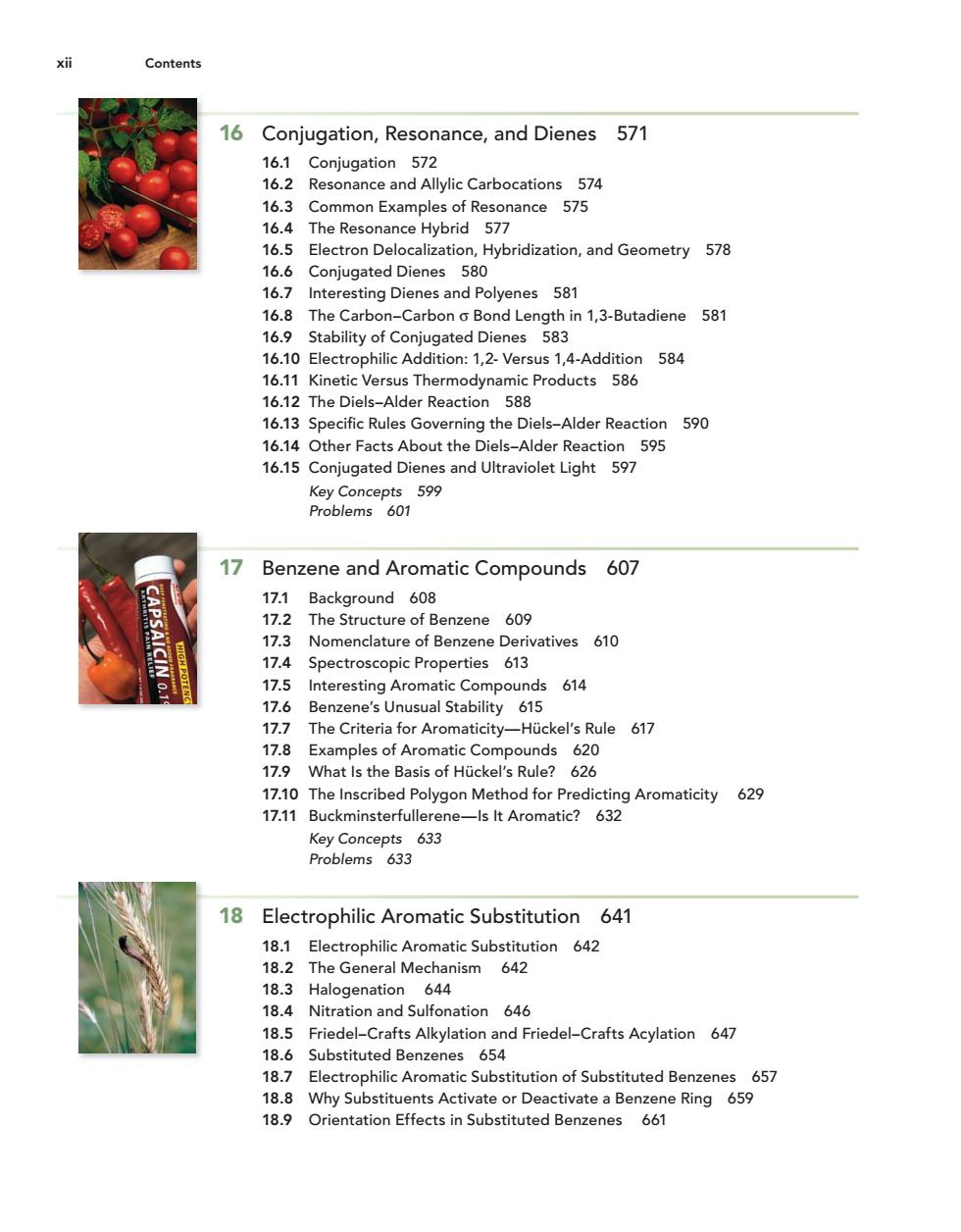正在加载图片...

xii Contents 16 Conjugation,Resonance,and Dienes 571 16. 8 74 Common Examples of Resonance 57 16.4 The Resonance Hybrid 577 16.5 Electron Delocalization,Hybridization,and Geometry 578 16.6 Conjugated Dienes 580 16.7 Interesting Dienes and Polyenes 581 16.8 The Carbon-Carbon c Bond Length in 1,3-Butadiene 581 16.9 Stability of Conjugated Dienes 583 16.10 Electrophilic Addition:1,2-Versus 1,4-Addition 584 16.11 Kinetic Versus Thermodynamic Products 586 16.12 The Diels-Alder Reaction 588 16.13 Specific Rules Go es anc Ultraviolet Light 597 17 Benzene and Aromatic Compounds 607 CAPSAICIN 17.1 Background 608 17.2 The Structure of Benzene 609 Nomenclature of Benzene Derivatives 610 Spectroscopic Properties 613 Interest 。 ua Stability 614 615 The Crit teria for Aroma Huckel's Rule 617 620 6 17.10 The Inscribed Polygon Method for Predicting Aromaticity 629 17.11 Buckminsterfullerene-ls It Aromatic?632 Key Concepts 633 Problems 633 18 Electrophilic Aromatic Substitution 641 The Ge eral me 642 Haloger ation 44 and Sul 646 -Crafts Alkylation and Friedel-Crafts Acylation 647 18.6 Substituted Benzenes 654 18.7 Electrophilic Aromatic Substitution of Substituted Benzenes 657 18.8 Why Substituents Activate or Deactivate a Benzene Ring 659 18.9 Orientation Effects in Substituted Benzenes 661 xii Contents 16 Conjugation, Resonance, and Dienes 571 16.1 Conjugation 572 16.2 Resonance and Allylic Carbocations 574 16.3 Common Examples of Resonance 575 16.4 The Resonance Hybrid 577 16.5 Electron Delocalization, Hybridization, and Geometry 578 16.6 Conjugated Dienes 580 16.7 Interesting Dienes and Polyenes 581 16.8 The Carbon–Carbon σ Bond Length in 1,3-Butadiene 581 16.9 Stability of Conjugated Dienes 583 16.10 Electrophilic Addition: 1,2- Versus 1,4-Addition 584 16.11 Kinetic Versus Thermodynamic Products 586 16.12 The Diels–Alder Reaction 588 16.13 Specifi c Rules Governing the Diels–Alder Reaction 590 16.14 Other Facts About the Diels–Alder Reaction 595 16.15 Conjugated Dienes and Ultraviolet Light 597 Key Concepts 599 Problems 601 17 Benzene and Aromatic Compounds 607 17.1 Background 608 17.2 The Structure of Benzene 609 17.3 Nomenclature of Benzene Derivatives 610 17.4 Spectroscopic Properties 613 17.5 Interesting Aromatic Compounds 614 17.6 Benzene’s Unusual Stability 615 17.7 The Criteria for Aromaticity—Hückel’s Rule 617 17.8 Examples of Aromatic Compounds 620 17.9 What Is the Basis of Hückel’s Rule? 626 17.10 The Inscribed Polygon Method for Predicting Aromaticity 629 17.11 Buckminsterfullerene—Is It Aromatic? 632 Key Concepts 633 Problems 633 18 Electrophilic Aromatic Substitution 641 18.1 Electrophilic Aromatic Substitution 642 18.2 The General Mechanism 642 18.3 Halogenation 644 18.4 Nitration and Sulfonation 646 18.5 Friedel–Crafts Alkylation and Friedel–Crafts Acylation 647 18.6 Substituted Benzenes 654 18.7 Electrophilic Aromatic Substitution of Substituted Benzenes 657 18.8 Why Substituents Activate or Deactivate a Benzene Ring 659 18.9 Orientation Effects in Substituted Benzenes 661 smi75625_fm_00i-xxxiv.indd xii 11/17/09 11:21:27 AM